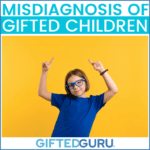There are entire books written about misdiagnosis of gifted kids.
Why? Because in a number of children, giftedness looks like an alphabet soup of issues and disorders.
- They can look like they’re on the Autism spectrum (when they’re not).
- They can look like they have ADHD (when they do not.)
- They can look like they have OCD (when they don’t).
- They can look like they have Oppositional Defiance Disorder (when they don’t).
And the list goes on. And on.
Of course, it’s not always misdiagnosis. Giftedness can coexist with many conditions.
However, it’s very, very common for gifted kids to appear with behaviors that we typically associate with disorders which are in fact characteristics of giftedness.

Why do gifted children get misdiagnosed?
The characteristics of giftedness, such as high energy and heightened sensitivity, may be mistaken for symptoms of attention deficit hyperactivity disorder (ADHD) or other conditions.
Furthermore, many educators and healthcare professionals may not be familiar with the signs of giftedness, which can lead to a misdiagnosis.
Even when the diagnosis is correct, giftedness complicates the therapeutic approach.
Dr. James Webb writes, “In some situations where gifted children have received a correct diagnosis, giftedness is still a factor that must be considered in treatment, and should really generate a dual diagnosis. For example, existential depression or learning disability, when present in gifted children or adults, requires a different approach because new dimensions are added by the giftedness component. Yet the giftedness component typically is overlooked due to the lack of training and understanding by health care professionals (Webb & Kleine, 1993).”
Let’s unpack this some more.
Hyperfocus and esoteric interests can be a problem.
Gifted students often have intense focus on things of interest to them to the exclusion of things that other people find of value (like eating, sleeping, and personal hygiene). This is common in people with ADHD (called “hyperfocus”).
Additionally, gifted individuals often have interests in things that nobody else is interested in to the point where it’s off-putting to other people.
Combine that with a fixation on things being correct, and you’ve got a social skills train wreck.
I see this dynamic a lot: Someone says something like, “The brontosaurus isn’t a real dinosaur.” The budding paleontologist gifted kid cannot let this go.
“Oh, that used to be true because in 2012 they thought it never existed, but in 2015 it regained its status, and now we know it really was a species of dinosaur.”
Often, gifted kids will have yet to meet a hill they won’t die on. That rigidity is perceived as a sign of disordered thinking.
Why do gifted students get misdiagnosed with ADHD?
In the ADHD realm, gifted kids appear easily bored because they’re presented with material far behind what they are capable of. This can look like ADHD Inattentive type, even though it’s really Meaningful Work Disorder (not a real disorder, but it should be).
ADHD can also present as the Hyperactive type when gifted kids are bored in a class, and they use psychomotor movement in order to manage that boredom.
So they look like they’re hyperactive, but really, they are just using their body to try to release that unused mental energy that everybody else needs in class and they don’t need.
They’re having to use all their mental energy just trying to sit in the chair because it’s so boring and they’re ten steps ahead of the teacher, thinking, “Are you going to get there like? Are we ever gonna get there?
Gifted students can have ADHD. However, often what looks like ADHD is really giftedness trying to live in a world not made for it.
My favorite book about this is Gnaulati’s Back to Normal. You can find this and other recommendations on my Amazon page of books for parents and educators of the gifted.

Why asynchronous development causes issues.
Asynchronous means “out of time,” and that’s exactly what we mean. Asynchronous development in gifted children is an uneven development in their intellect, physical growth, and/or emotional maturity.
This can lead to difficulties with social interactions and emotional regulation, despite their advanced cognitive abilities.
Asynchronous development is a hallmark of giftedness, so if you are teaching or parenting a gifted child, it’s important to understand it.
Dan Peters has a great (short) YouTube video on this that’s worth watching.
Asynchronous development causes issues with misdiagnosis because the child may talk like a college professor who got shrunk in the dryer while simultaneously throwing a temper tantrum when their favorite show is preempted for a national emergency.
If the diagnoser only sees the college professor (or the tantrumer), misdiagnosis is almost inevitable.
Why a lack of understanding of giftedness causes problems.
In the DSM-V, the manual mental health professionals use to diagnose disorders, the ADHD criteria section says that the person must meet the required number of criteria, “and they are inappropriate for developmental level.”
For gifted students, that’s problematic.
Many ADHD criteria are in the normal range in their development. What that means is that something may be associated with ADHD in a typical child while being in the realm of normal development for a gifted child.
Additionally, the overexcitabilities and intensities we often associate with giftedness can also mimic diagnostic criteria for a host of conditions.

Intensities/Overexcitabilities
Intensities/Overexcitabilities are a part of the theory of positive disintegration (TPD) developed by Polish psychologist Kazimierz Dąbrowski.
The TL:DR (Too Long: Didn’t Read) on TPD:
TPD is a concept of personality development, and according to TPD, growth occurs through a series of disintegrations and integrations.
Disintegration refers to the breaking down of existing values or beliefs, which is seen as a positive development in an individual’s life.
The theory of positive disintegration (TPD) identifies five areas of overexcitabilities: psychomotor, sensual, imaginational, intellectual, and emotional.
While some research [Mendaglio, S., & Tillier, W. (2006)] indicates that the connection between giftedness and overexcitabilities/intensities may not be as strong as once thought, they are very, very common.
These intensities are another confounding factor in diagnosis.
Does the child who will only eat white food or whose brain feels like it’s going to explode if exposed to buzzing florescent lights have a sensory disorder? Or is it an overexcitability?
You can see how complicated this issue can become (very quickly).
Why do gifted students get misdiagnosed with OCD?
Gifted children may be misdiagnosed with OCD because they tend to be perfectionists and idealists who place high value on rules and order.
I’ve written an entire book on perfectionism, so I’ve spent hundreds of hours exploring this dynamic. It’s real, but it’s not OCD.
They also like to organize things into complex structures, which can be mistaken for obsessive-compulsive behavior.
However, these traits are common in gifted children and do not necessarily indicate a disorder.
As my best friend (a licensed therapist) says, “It’s only a disorder if it doesn’t work for you.”
That’s not true when taking to the extreme, of course, but there is something to that statement.
Why do gifted students get misdiagnosed with ODD (Oppositional Defiant Disorder)?
Our strengths and our weaknesses are two sides of the same coin. That same sense of justice that makes them a powerful force for good can become problematic when taken to an extreme.
Additionally, the intensities/overexcitabilities so common in gifted kids (see above) can influence this as well.
Gifted children may be misdiagnosed with oppositional defiance disorder (ODD) due to their strong-willed nature and tendency to question rules.
This is especially true for gifted males from poverty or other marginalized groups, as they are more likely to be identified as having ODD rather than being gifted.
Jim Chandler says, “Children and adolescents with ODD will find the weakness in the family system and exploit it. Is there tension between father and mother? They will aim to worsen this. Trouble with the in-laws? These children and adolescents will try to exploit this. Are you out of shape and exhausted after work? That’s when they will be most trying. Are you worried or depressed about something? They will try to figure it out and torment you.”
This is true of school systems as well as those in families.
When you get a gifted student who can be a master manipulator because of their intelligence, it can be a fireworks show.
Abilities Mask Difficulties
The misdiagnosis works both ways. Sometimes, their giftedness can interfere with needed diagnoses.
Gifted children may be misdiagnosed because their advanced abilities can mask underlying learning or behavioral issues.
In their article Why Are Assessments and Screening Tools Missing Co-occurring Diagnoses of Gifted Kids?, Greebel et al argue that, “The first, and perhaps most common [reason for misdiagnosis], is that gifted kids are excellent maskers.”
They compensate.
Dr. Dan Peters has discussed “stealth dyslexia” that can happen when strong verbal skills cloak underlying dyslexia until much later ages than most students would be diagnosed.
Greebel et al explain that this delay is problematic. “When they seek services in adolescence, they may struggle because some diagnoses require evidence of childhood presentation. It’s not that the presentation wasn’t there in childhood — it’s that the child masked and as the demand increased, the masking became harder.”
Do you see the problem here?
They’re masking, so they don’t get evaluated. When they do get evaluated, it’s not possible to give a diagnosis because they masked so well that no one noticed when they were young enough for it to count.
What do we do about the misdiagnosis of gifted children?
If you read the published research and articles written about this issue, the two key takeaways are:
- More research is needed.
- Practitioners need a better understanding of gifted traits.
Because parents and teachers don’t have control over these factors, I have a few more ideas for you.
- The most important thing you can do is educate yourself so you can be a strong and effective advocate.
To help you, I curate a list of recommended reading on my Amazon list.
- If you think your child may need an evaluation, look for help from someone on the SENG Provider Referral Directory. These professionals have taken at least some training on giftedness and all have an interest in it.
- Help your child understand that giftedness doesn’t mean that everything is rainbows and unicorns. There are challenges that come with it, too. That doesn’t mean they’re broken or that something is wrong with them.
- If they do have a disorder coexisting with their giftedness, seek quality help, even if it takes several tries.
Misdiagnosis and overdiagnosis are real issues, but we have a lot of power to make it better for the children with whom we work and live.
Citations:
Centers for Disease Control and Prevention. (2022, August 9). Symptoms and diagnosis of ADHD. Centers for Disease Control and Prevention. https://www.cdc.gov/ncbddd/adhd/diagnosis.html
Chandler, J. (n.d.). Oppositional Defiant Disorder (ODD) and Conduct Disorder (CD) in Children and Adolescents: Diagnosis and Treatment Oppositional Defiant Disorder (ODD). https://jamesdauntchandler.tripod.com/ODD_CD/oddcdpamphlet.pdf
Dabrowski,K.(1970). Mental growth through positive disintegration. London: Gryf.
Enrico Gnaulati, PhD. (2013). Back to Normal. Beacon Press.
Greebel, J. R., Melissa Sornik, & Jacob. (2022, December 12). Why Are Assessments and Screening Tools Missing Co-occurring Diagnoses of Gifted Kids? SENG. https://www.sengifted.org/post/why-are-assessments-and-screening-tools-missing-co-occurring-diagnoses-of-gifted-kids
Mendaglio, S., & Tillier, W. (2006). Dabrowski’s Theory of Positive Disintegration and Giftedness: Overexcitability Research Findings. Journal for the Education of the Gifted, 30(1), 68–87. https://doi.org/10.1177/016235320603000104
Piechowski, M. M.(1986). The concept of developmental potential. Roeper Review, 8, 190–197.
Webb, J. T. (2016). Misdiagnosis and dual diagnoses of gifted children and adults : ADHD, bipolar, OCD, Asperger’s, depression, and other disorders. Great Potential Press, Inc.
Webb, J. T. (Updated 2019). Post | SENG. (2019). SENG. https://www.sengifted.org/post/misdiagnosis-and-dual-diagnosis-of-gifted-children












